Feel the Beat Cardigan |
|||||||||||||
 |
 |
||||||||||||
Knitted jacket in DROPS Cotton Light. The piece is worked top down with raglan and lace pattern. Sizes XS - XXL.
DROPS 240-25 |
|||||||||||||
|
------------------------------------------------------- EXPLANATIONS FOR THE PATTERN: ------------------------------------------------------- RIDGE/GARTER STITCH (worked back and forth): Knit all rows. 1 ridge = knit 2 rows. PATTERN: See diagrams A.1 to A.4. Choose diagram for your size (applies to A.3). The diagrams show all rows in the pattern from the right side. RAGLAN: All increases are worked from the right side. There are 4 stocking stitches in each raglan-line. The marker-threads sit in the middle of these 4 stitches. Increase 4 stitches in each raglan-line, (i.e. 2 stitches towards the right before the marker-thread and 2 stitches towards the left after the marker-thread). Increase as follows: BEFORE MARKER-THREAD: Work until there are 2 stitches left before the marker-thread, use the left needle to pick up the strand between 2 stitches from the previous round, pick up strand from behind and knit the front loop, knit 1, use the left needle to pick up the strand between 2 stitches from the previous round as before and knit the front loop, knit 1. AFTER MARKER-THREAD: Knit 1, use the left needle to pick up the strand between 2 stitches from the previous round, pick up strand from the front and knit the back loop, knit 1, use the left needle to pick up the strand between 2 stitches from the previous round as before and knit the back loop. BUTTONHOLES: Work buttonholes on the right band (when the garment is worn). Work from the right side when there are 4 stitches left on the row as follows: Make 1 yarn over, knit 2 together and knit 2. On the next row (wrong side), knit the yarn over to leave a hole. The first buttonhole is worked when the rib on the neck is finished. The other 4-4-5-5-5-5 buttonholes are worked with approx. 9-9½-8-8½-9-9½ cm between each one. ------------------------------------------------------- START THE PIECE HERE: ------------------------------------------------------- JACKET – SHORT OVERVIEW OF THE PIECE. The neck and yoke are worked back and forth with circular needle, from mid front and top down. The yoke is divided for the back piece, front pieces and sleeves and each is finished separately, back and forth with circular needle. The piece is sewn together leaving a split in each side. NECK: Cast on 118-120-126-130-136-140 stitches with circular needle size 3 mm and DROPS Cotton Light. Work 6 RIDGES back and forth – read description above. YOKE: Change to circular needle size 4 mm. Insert 1 marker inside the outermost 6 stitches on one side; the yoke is measured from this marker! Knit 1 row from the right side – remember the BUTTONHOLES on the right band – read description above. Purl 1 row from the wrong side with the outermost 6 stitches on each side in garter stitch (bands). Insert 4 marker-threads, without working the stitches and inserted between 2 stitches as follows: Count 22-22-24-24-26-26 stitches (front piece), insert 1 marker-thread, count 20-20-20-22-22-22 stitches (sleeve), insert 1 marker-thread, count 34-36-38-38-40-44 stitches (back piece), insert 1 marker-thread, count 20-20-20-22-22-22 stitches (sleeve), insert 1 marker-thread. There are 22-22-24-24-26-26 stitches left after the last marker-thread (front piece). Work the first row from the right side as follows: 6 garter stitches, work A.1 6-6-7-7-8-8 times, A.2, increase for RAGLAN before and after the marker-thread – read description above (4 stitches increased), work A.3 (sleeve), increase for raglan before and after the marker-thread, work A.4, then A.1 13-14-15-15-16-18 times, A.2, increase for raglan before and after the marker-thread, work A.3 (sleeve), increase for raglan before and after the marker-thread, work A.4, then A.1 6-6-7-7-8-8 times, 6 garter stitches = 134-136-142-146-152-156 stitches. Continue this pattern and increase for raglan every 6th row. Each time you increase, there is room for 1 more repeat of A.1 in width – i.e. the lace pattern is always worked up to the 4 stitches in each raglan-line. REMEMBER THE KNITTING TENSION! When you have increased for raglan 7-8-8-9-9-10 times, there are 230-248-254-274-280-300 stitches. The increases are finished in sizes XS and S. Go to ALL SIZES. In the other sizes continue as follows: SIZE M: The increases are finished on the front/back pieces. Continue the pattern for 5 rows without increasing. The next row is worked as follows from the right side: Increase for raglan only on the sleeves (8 stitches increased) = 262 stitches. Go to ALL SIZES. SIZES L, XL and XXL: The increases are finished on the sleeves. Continue the pattern for 5 rows without increasing. The next row is worked as follows from the right side: Increase for raglan only on the back and front pieces (8 stitches increased) = 282-288-308 stitches. Go to ALL SIZES. ALL SIZES: = 230-248-262-282-288-308 stitches. Continue the pattern back and forth without further increases (with 4 stocking stitches in each raglan-line and the bands in garter stitch) until the yoke measures 19-20-21-22-24-26 cm from the marker on the neck. On the next row from the right side divide the piece as follows: Work 38-40-42-46-48-50 stitches (left front piece), place the next 44-48-52-54-54-58 stitches on a thread for the sleeve, place the next 66-72-74-82-84-92 stitches on a thread for the back piece, place the next 44-48-52-54-54-58 stitches on a thread for the sleeve and place the last 38-40-42-46-48-50 stitches on a thread for the right front piece. Each piece is finished separately. LEFT FRONT PIECE: After the 38-40-42-46-48-50 stitches worked from the right side, cast on 4-4-6-6-8-8 stitches (in side under sleeve) = 42-44-48-52-56-58 stitches. Continue the pattern back and forth with 4 garter stitches towards the side and 6 garter stitches mid-front – make sure the pattern matches the yoke. When the piece measures 26-27-28-28-28-28 cm from the division, and the next row is from the right side, change to needle size 3 mm. Work 4 ridges over all stitches and increase 14-17-17-18-18-23 stitches evenly on the first row (do not increase over the band or edge stitches) = 56-61-65-70-74-81 stitches. Cast off with knit from the right side. The piece measures approx.52-54-56-58-60-62 cm from the shoulder. RIGHT FRONT PIECE: Cast on 4-4-6-6-8-8 stitches with circular needle size 4 mm, then work pattern as before from the right side over the 38-40-42-46-48-50 stitches on the right front piece = 42-44-48-52-56-58 stitches. Continue the pattern back and forth with 4 garter stitches towards the side and 6 garter stitches mid-front – make sure the pattern matches the yoke. When the piece measures 26-27-28-28-28-28 cm from the division, and the next row is from the right side, change to needle size 3 mm. Work 4 ridges over all stitches and increase 14-17-17-18-18-23 stitches evenly on the first row = 56-61-65-70-74-81 stitches. Cast off with knit from the right side. BACK PIECE: Cast on 4-4-6-6-8-8 stitches with circular needle size 4 mm, then work pattern as before from the right side over the 66-72-74-82-84-92 stitches on the back piece, cast on 4-4-6-6-8-8 stitches at the end of the row = 74-80-86-94-100-108 stitches. Continue the pattern back and forth with 4 garter stitches on each side. When the piece measures 26-27-28-28-28-28 cm from the division, and the next row is from the right side, change to needle size 3 mm. Work 4 ridges over all stitches and increase 26-30-32-34-36-42 stitches evenly spaced = 100-110-118-128-136-150 stitches. Cast off with knit from the right side. SLEEVES: Cast on 4-4-6-6-8-8 stitches with circular needle size 4 mm and continue the pattern from the right side over the 44-48-52-54-54-58 sleeve stitches on one side of the piece. Cast on 4-4-6-6-8-8 stitches at the end of the first row = 52-56-64-66-70-74 stitches. Continue with 4 garter stitches on each side – make sure the pattern matches the yoke. When the sleeve measures 38-39-38-38-36-35 cm from the division, and the next row is from the right side, change to needle size 3 mm. Work 4 ridges over all stitches and increase 22-22-26-26-28-28 stitches evenly on the first row = 74-78-90-92-98-102 stitches. Cast off with knit from the right side. The sleeve measures approx. 40-41-40-40-38-37 cm from the division. Work the other sleeve in the same way. ASSEMBLY: Sew the sleeve seams in the outermost loop of the outermost stitch so the seam is flat. Sew the side seams in the same way – start at the armhole and work down, leaving a 16-16-18-18-20-20 cm split at the bottom. Sew the openings under the sleeves. Sew the buttons onto the left band. |
|||||||||||||
Diagram explanations |
|||||||||||||
|
|||||||||||||
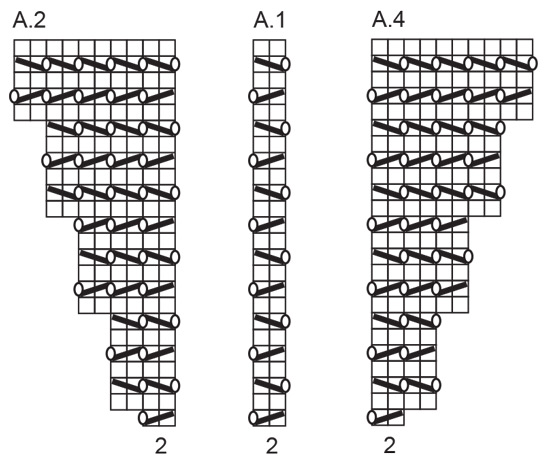
|
|||||||||||||
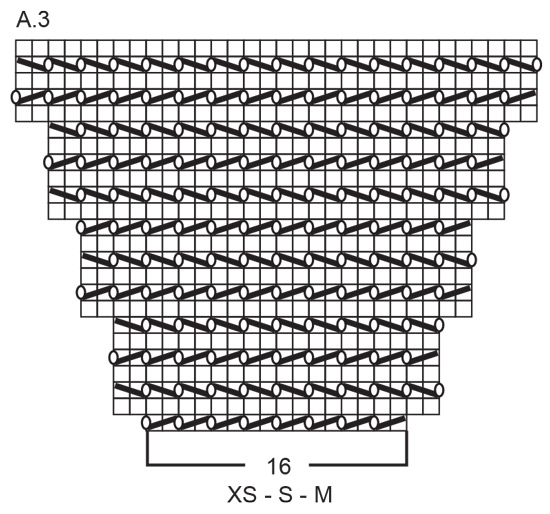
|
|||||||||||||
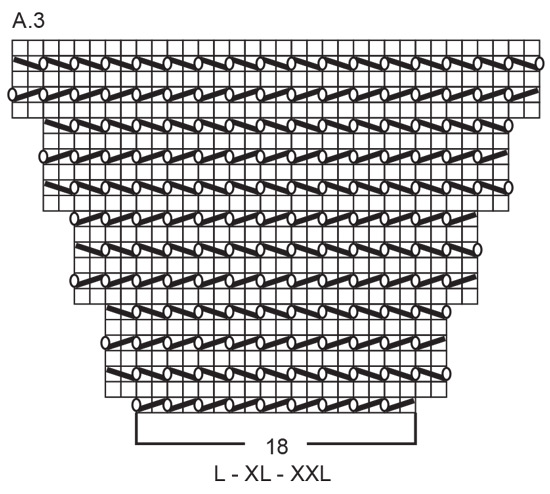
|
|||||||||||||

|
|||||||||||||
|
Have you made this or any other of our designs? Tag your pictures in social media with #dropsdesign so we can see them! Do you need help with this pattern?You'll find tutorial videos, a Comments/Questions area and more by visiting the pattern on garnstudio.com. © 1982-2024 DROPS Design A/S. We reserve all rights. This document, including all its sub-sections, has copyrights. Read more about what you can do with our patterns at the bottom of each pattern on our site. |
|||||||||||||








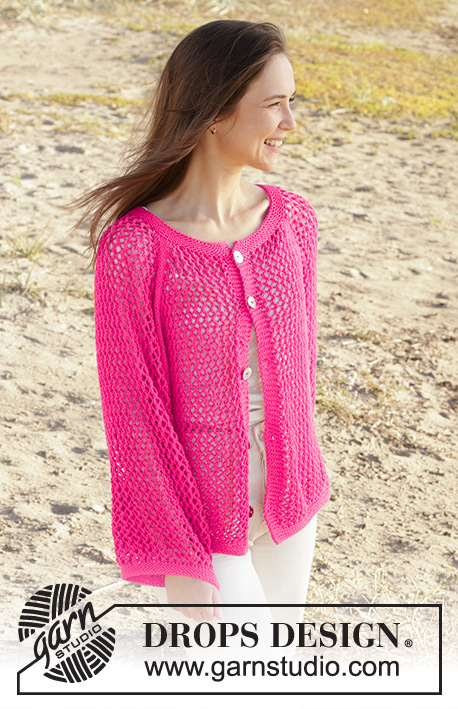


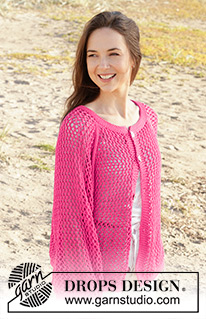



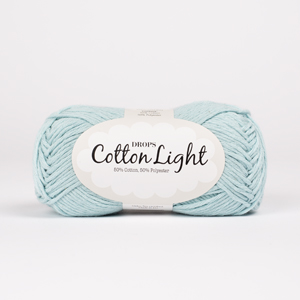







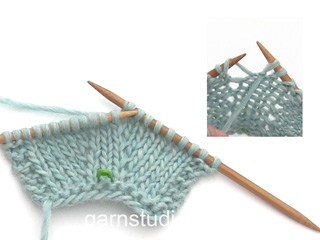












































Comments / Questions (10)
Avrei necessità di capire bene come fare gli aumenti del raglan. C'è per favore un video che spiega questo passaggio? Grazie!
07.01.2024 - 23:37DROPS Design answered:
Buonasera Lucia, non c'è un video specifico per questo passaggio: può spiegarci meglio cosa la mette in difficoltà? Buon lavoro!
09.01.2024 - 20:07De modellen op de foto's zijn altijd heel mooi maar waarom nooit een foto van de rugzijde/achterkant van het patroon. Soms is dat echt een must om te zien hoe het model achteraan valt.
23.07.2023 - 20:57Hallo, warum werden die vordere Teilen und der Rücken unter den Ärmeln getrennt gestrickt? Kann ich das nicht als ein Teil in hin und rück Reihen weiter Stricken? Danke
15.06.2023 - 22:00DROPS Design answered:
Liebe Elena, dies ist wahrscheinlich die Wahl der Designerin, einige Strickerinnen stricken lieber einzelne Teilen. Viel Spaß beim stricken!
16.06.2023 - 07:23"Im Lochmuster in Hin- und Rück-Reihen weiterstricken, mit 6 Maschen kraus rechts am vorderen Rand und 4 Maschen kraus rechts an der Seite – darauf achten, dass das Muster passend über den Maschen der Passe fortgesetzt wird. " Hallo, heißt das, dass über die 4 Maschen der Raglanlinie weiterhin 4 M glatt rechts gestrickt wird oder wird nun das Lochmuster über diese 4 M gestrickt? Vielen Dank!
11.04.2023 - 20:05DROPS Design answered:
Liebe Tanja, die 4 Maschen gegen die Seite werden jetzt kraus rechts gestrickt, dh Sie stricken die 6 Blenden-Maschen und das Lochmuster wie zuvor und die 4 Maschen gegen die Seiten (am Ende der Hin-Reihe für das linke Vorderteil/Anfang der Hin-Reihe für das rechte Vorderteil) werden krausrechts gestrickt. Viel Spaß beim stricken!
12.04.2023 - 08:26Las instrucciones del patrón dicen que se comienza realizando 6 surcos, y que un surco son dos vueltas, o sea, 12 vueltas para el borde del cuello. Parece un error y que fuesen 3 surcos. ¿Me lo podríais aclarar? Muchas gracias de antemano
06.04.2023 - 20:07DROPS Design answered:
Hola Inma, el patrón es correcto, el escote es bastante ancho, tal y como se ve en la foto. Así que son 6 surcos o 12 vueltas. Pero si prefieres puedes trabajar una cenefa más estrecha, con menos surcos.
07.04.2023 - 00:07Ich habe die Maschenzahl für die Jacke in Große S gesteickt, aber nach dem Passe und das Abzählen sind zu wenig Maschen übrig... was soll ich machen
02.04.2023 - 23:12DROPS Design answered:
Liebe Monica, beim Lochmuster sollen Sie beachten, daß es genauso viele Umschläge als Abnahme gibt (noch kommen die Raglanzunahmen dazu). Am besten benutzen Sie Markierer, es kann Ihnen helfen, die Diagramme zu folgen. Viel Spaß beim stricken!
11.04.2023 - 10:55Rhododendron
22.01.2023 - 21:56Geranium
18.01.2023 - 13:54Mooie rose luchtige vest
18.01.2023 - 09:01Netzjacke
17.01.2023 - 17:14